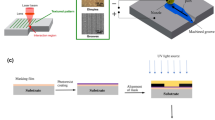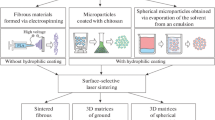Abstract
Laser beam deflection is a useful tool for studying the dynamics of the pulsed laser ablation mechanism, and has the advantage of being used as an in situ laser damage monitoring technique for both bulk and thin film polymeric and biological tissue samples. This work employs the photothermal deflection technique to study possible photo-acoustic phenomena during the excimer laser ablation of biocompatible polytetrafluoroethylene (PTFE) and to examine the crater surface quality by video microscopy.
Although photo-acoustic phenomena are detected in the laser fluence threshold region, ablation is mainly the result of the photothermal process.
Similar content being viewed by others
References
Ossof RH, Koriwchak MJ, Netterville JL, Duncavage JA. Difficulties in endoscopie removal of teflon granulomas of the vocal fold.Ann Otol Rhinol Laryngol 1993,102:405–12
Bentz M, Parva B, Dickson C et al. Laser assisted microvascular anastomoses of human fetal artery, human adult artery, and expanded polytetrafluoro-ethylene microconduit.Lasers Surg Med 1992 (abstract): 19
Kuper S, Stuke M. Ablation of polytetrafluoroethylene (Teflon) with femtosecond UV excimer laser pulses.Appl Phys Lett 54:4–6
Makropoulou M, Serafetinides AA, Skordoulis CD. Ultra-violet and infra-red laser ablation studies of biocompatible polymers.Lasers Med Sci 1995,10:201–5
Furzikov NP. Approximate theory of highly absorbing polymer ablation by nanosecond laser pulses.Appl Phys Lett 1990,56:1638–40
Kukreja LM, Hess P. Time evolution of laser-induced polymer ablation studied by attenuation of a probe He-Ne laser beam.Appl Surf Sei 1994, 79/80:158–64
Doukas AG, Zweig AD, Frisoli JK, Birngruber R, Deutsch TF. Non-invasive determination of shock wave pressure generated by optical breakdown.Appl Phys B 1991,53:237–45
Sell JA, Heffelfinger DM, Ventzek PLG, Gilgenbach RM. Photoacoustic and photothermal beam deflection as a probe of laser ablation of materials.J Appl Phys 1991,69:1330–6
Cummins JP, Walsh JT. Tissue tearing caused by pulsed laser-induced ablation pressure.Appl Optics 1993,32:494–503
Haase KK, Hanke H, Baumbach A et al. Occurrence, extent and implication of pressure waves during excimer laser ablation of normal arterial wall and atherosclerotic plaque.Lasers Surg Med 1993,13:263–70
Karabutov A, Podymova N, Letokhov V. Acoustic wave monitoring during laser ablation of tissue.Proc SPIE 1996,2624:93–102
Doukas AG, Flotte TJ. Physical characteristics and biological effects of laser-induced stress waves.Ultrasound Med Biol 1996,22:151–64
Esenaliev RO, Oraevsky AA, Letokhov VS, Karabutov AA, Malinsky TV. Studies of acoustical and shock waves in the pulsed laser ablation of biotissue.Lasers Surg Med 1993,13:470–84
Rosencwaig A, Gersho A. Theory of the photoacoustic effect with solids.J Appl Phys 1976,47:64–9
Paltauf G, Schmidt-Kloiber H. Microcavity dynamics during laser-induced spallation of liquids and gels.Appl Phys 1996,A62:303-ll
Tam AC. Applications of photoacoustic sensing techniques.Rev Mod Phys 1986,58:381–431
Kroschwitz JI.Concise Encyclopedia of Polymer Science and Engineering. London: John Wiley and Sons, 1990
Gorodetsky G, Kazyaka TG, Melcher L, Srinivasan R. Calorimetric and acoustic study of ultraviolet laser ablation of polymers.Appl Phys Lett 1985,46:828–30
Dyer PE, Srinivasan R. Nanosecond photoacoustic studies on ultraviolet laser ablation of organic polymers.Appl Phys Lett 1986,48:445–7
Lazare S, Granier V. UV laser photoablation of polymers: a review and recent results.Laser Chem 1989,10:25–41
Goodwin PM, Otis CE. Ultraviolet photoablation of p-tetrafluoroethylene: Rotational energy distributions of the CF radical and time resolved mass spectra.J Appl Phys 1991,69:2584–8
Paterson LM, Dickinson MR, King TA. Laser generated acoustic wave on tattoo pigment.Proc SPIE 1988,2624:42–8
Albagli D, Dark M, von Rosenberg C, Perelman L, Itzkan I, Feld MS. Laser-induced thermoelastic deformation: A three-dimensional solution and its application to the ablation of biological tissue.Med Phys 1994,21:1323–31
Author information
Authors and Affiliations
Rights and permissions
About this article
Cite this article
Skordoulis, C.D., Makropoulou, M.I., Bolovinos, A.L. et al. XeCl laser ablation of biocompatible PTFE studied by photothermal beam deflection. Laser Med Sci 12, 313–319 (1997). https://doi.org/10.1007/BF02767153
Received:
Revised:
Accepted:
Issue Date:
DOI: https://doi.org/10.1007/BF02767153




